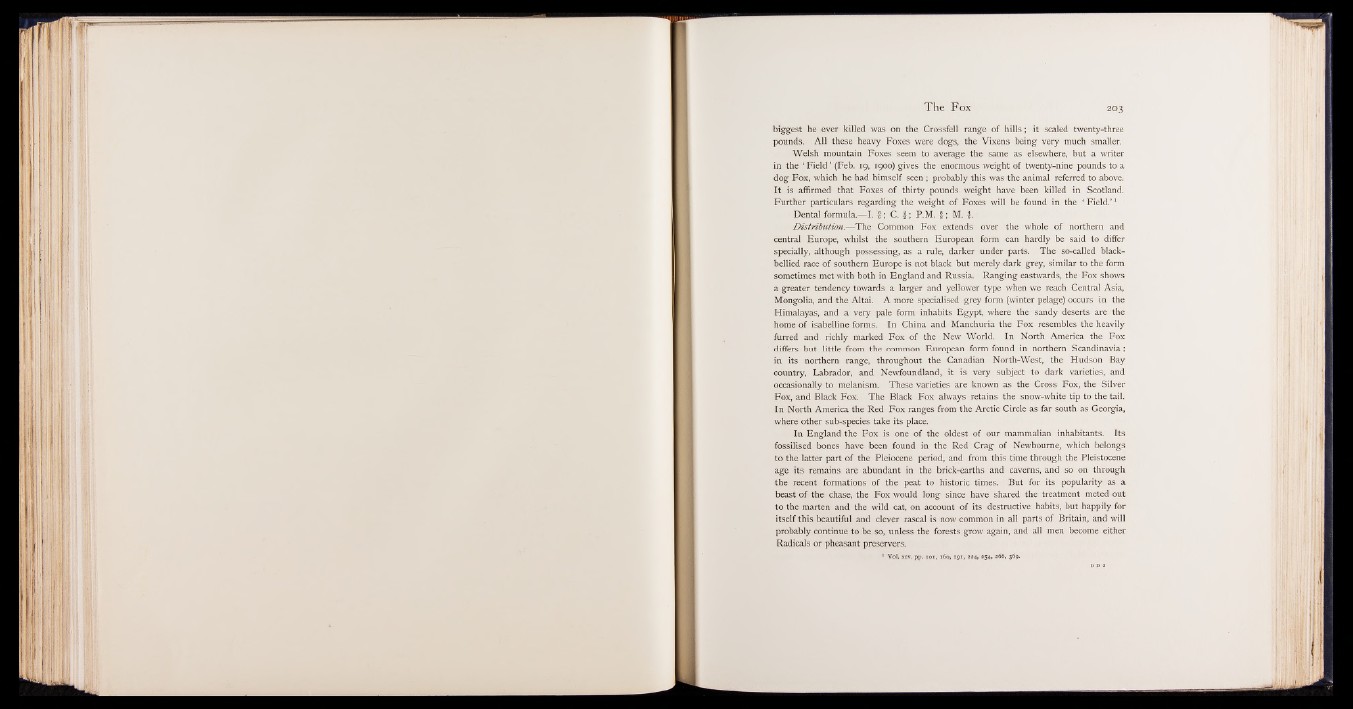
biggest he ever killed was on the Crossfell range of hills; it scaled twenty-three
pounds. All these heavy Foxes were dogs, the Vixens being very much smaller.
Welsh mountain Foxes seem to average the same as elsewhere, but a writer
in the ‘ Field ’ (Feb. 19, 1900) gives the enormous weight of twenty-nine pounds to a
dog Fox, which he had himself seen ; probably this was the animal referred to above.
It is affirmed that Foxes of thirty pounds weight have been killed in Scotland.
Further particulars regarding the weight of Foxes will be found in the ‘ Field.’ 1
Dental formula.—-I. | ; C. f ; P.M. f ; M. £.
Distribution.— The Common Fox extends over the whole of northern and
central Europe, whilst the southern European form can hardly be said to differ
specially, although possessing, as a rule, darker under parts. The so-called black-
bellied race of southern Europe is not black but merely dark grey, similar to the form
sometimes met with both in England and Russia. Ranging eastwards, the Fox shows
a greater tendency towards a larger and yellower type when we reach Central Asia,
Mongolia, and the Altai. A more specialised grey form (winter pelage) occurs in the
Himalayas, and a very pale form inhabits Egypt, where the sandy deserts are the
home of isabelline forms. In China and Manchuria the Fox resembles the heavily
furred and richly marked Fox of the New World. In North America the Fox
differs but little from the common European form found in northern Scandinavia;
in its northern range, throughout the Canadian North-West, the Hudson Bay
country, Labrador, and Newfoundland, it is very subject to dark varieties, and
occasionally to melanism. These varieties are known as the Cross Fox, the Silver
Fox, and Black Fox. The Black Fox always retains the snow-white tip to the tail.
In North America the Red Fox ranges from the Arctic Circle as far south as Georgia,
where other sub-species take its place.
In England the Fox is one of the oldest of our mammalian inhabitants. Its
fossilised bones have been found in the Red Crag of Newbourne, which belongs
to the latter part of the Pleiocene period, and from this time through the Pleistocene
age its remains are abundant in the brick-earths and caverns, and so on through
the recent formations of the peat to historic times. But for its popularity as a
beast of the chase, the Fox would long since have shared the treatment meted out
to the marten and the wild cat, on account of its destructive habits, but happily for
itself this beautiful and clever rascal is now common in all parts of Britain, and will
probably continue to be so, unless the forests grow again, and all men become either
Radicals or pheasant preservers.
1 Vol. xcv. pp. 101, 160, 191, 224, 254, 266, 369.